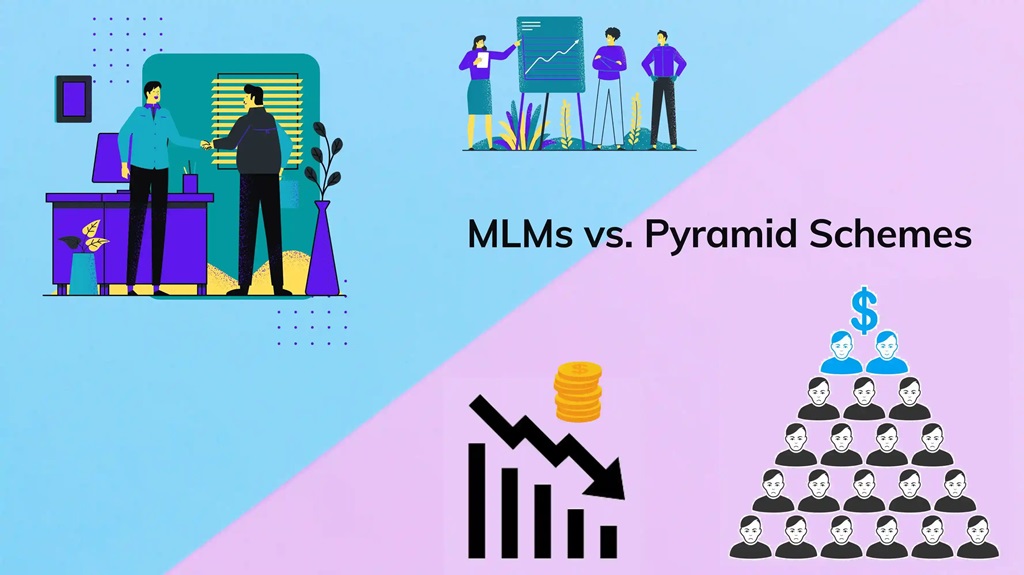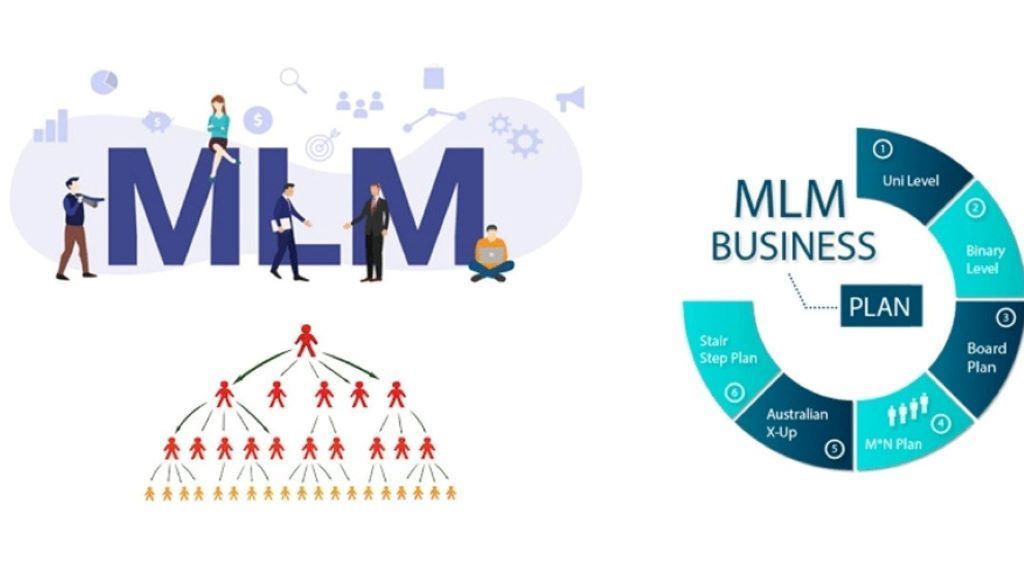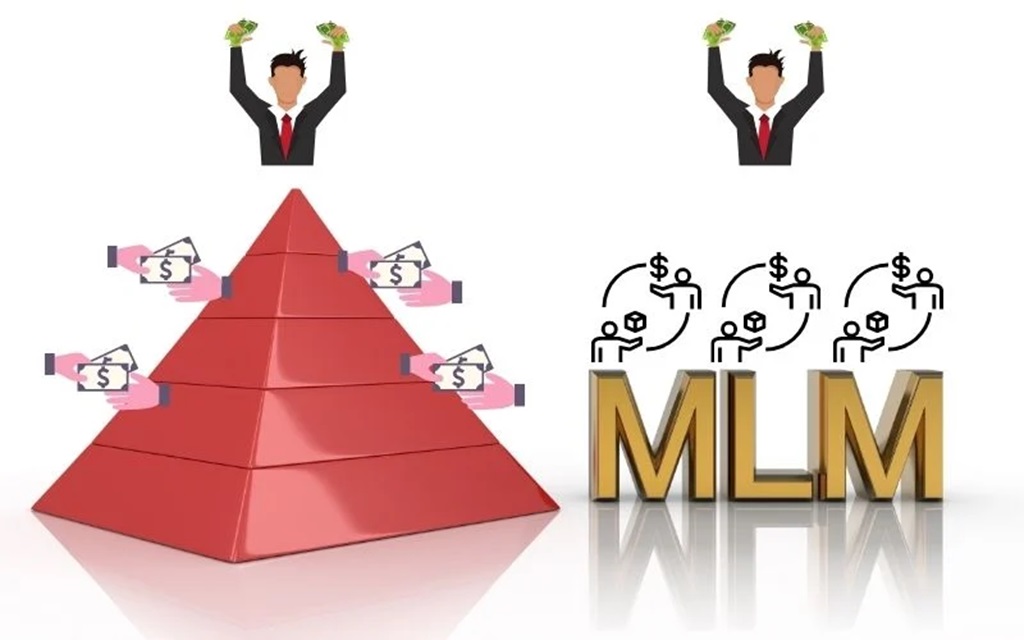
09 Jan How is MLM Different From a Pyramid Scheme?
Multi-level marketing (MLM) and pyramid schemes are often conflated, but they are distinctly different business models. Understanding the key differences between MLM and pyramid schemes can help you make informed decisions as a business owner or consumer.
MLMs sell various types of products, from health and wellness items to cosmetics, clothing, and more. Some of the most well-known MLMs operating today include Amway, Herbalife, Avon, Mary Kay, and Tupperware. To join an MLM, new participants usually need to pay an upfront cost to purchase a starter kit or inventory to get their business going. MLMs encourage – though don’t necessarily require – each salesperson to recruit new participants into their downlines to advance up the hierarchy.
What is Multi-Level Marketing (MLM)?

Multi-level marketing, often abbreviated as MLM, is a controversial sales strategy used by some direct sales companies. MLMs involve a hierarchical compensation structure where salespeople earn money both from their own sales of products to consumers as well as the sales of other people they recruit to join the company.
In an MLM, existing salespeople recruit new participants, referred to as the salesperson’s “downline.” If you are wondering is blue raven solar a pyramid scheme, it’s important to note that the upline receives compensation and commissions based not only on their own sales but also on the sales of their downline. This creates a hierarchy where those at the top earn more than those further down.
What is a Pyramid Scheme?
A pyramid scheme is a deceptive and unsustainable business model that lures people in with promises of making big money but relies on continued recruitment to generate profits rather than actual product sales.
Unlike MLMs that sell actual products, pyramid schemes mainly just encourage people to pay upfront costs to join in exchange for payments or commissions for enrolling other new members into the scheme.
In a classic pyramid scheme, you pay to join and then must recruit a certain number of other people beneath you, who also pay to join. A portion of each new recruit’s upfront costs then gets funneled back up to those higher in the pyramid.
The main way to make money in a pyramid scheme is by recruiting lots of people instead of by selling real products to genuine customers. But eventually the new recruits dry up and the pyramid collapses because there are not enough people paying in at the bottom to support those at the top.
Pyramid schemes are illegal in most countries due to their exploitative nature and tendency to inevitably collapse. Some infamous pyramid schemes include the Ponzis Scheme, Airplane Game, and BitConnect.
Key Differences Between MLM and Pyramid Schemes
While MLMs and pyramid schemes may seem quite similar on the surface, there are some important distinctions between these two business models:
1. MLMs Sell Genuine Products
The main difference is that MLMs sell real, legitimate products or services to actual customers, even if their product claims are sometimes dubious. Their compensation structure rewards salespeople for selling products.
Pyramid schemes, on the other hand, don’t sell any real products. They simply shuffle money around from newer recruits to older members in an unsustainable manner until the scheme inevitably collapses.
2. MLMs Are Legal; Pyramid Schemes Are Not
MLMs operate legally in most countries and are regulated as direct sales businesses. However, the legality of MLMs is sometimes called into question.
Pyramid schemes are outright illegal in most places because they are inherently unstable and based entirely on recruitment rather than product sales. There are rarely real customers involved in pyramid schemes.
3. MLMs Offer Products People Want
MLMs sell household goods, cosmetics, clothing, health products, and more that appeal to many consumers. The products may be overpriced, but they tend to be real, usable items that people want.
Pyramid schemes do not focus on genuine products – they just take money from recruits and funnel it to those higher up. The “product” is only membership in the pyramid scheme itself.
4. MLMs Can Have Long-Term Sustainability
Legitimate MLMs can persist for many years by selling in-demand products to a large customer base, though the majority of participants often lose money.
Pyramid schemes inevitably collapse quickly when recruitment dies down and new money can’t be funneled upward anymore. They are inherently designed to fail.
5. MLMs Can Have Retail Sales Focus
While some MLMs rely heavily on recruitment, the most ethical MLMs put emphasis on retail sales to outside consumers. Participants should be able to profit from actual product sales, not just new recruits.
Pyramid schemes have close to zero focus on retail sales, since the “products” are just memberships in the scheme itself with no external retail customers.
6. MLMs Pay Commissions on Product Sales
In an MLM, salespeople earn commissions from their own product sales, as well as the sales of their downline. So you can profit from both your own customers and your team’s customers.
But in a pyramid scheme, people only “earn” money by recruiting new members into the scheme and charging them upfront fees to join. No products change hands.
7. MLMs Are Not Guaranteed Income
While MLMs promise big earning potential, income is never guaranteed. Results vary widely and most participants end up losing money rather than profiting.
Pyramid schemes often guarantee easy money just for recruiting others. But in reality, only those at the very top make money and most people lose out when the scheme collapses.
8. MLMs Have Lower Risk
Though many people lose money in MLMs, participants usually only invest a few hundred dollars for starter kits and products, so financial losses are often limited.
In pyramid schemes, people are pressured to invest thousands of dollars upfront in the hopes of big payouts later. Losses can be huge when the scheme folds.
9. MLMs Must Buy Back Inventory
Legitimate MLMs must offer to buy back unsold product inventory from participants if they leave the company, so there is less financial risk involved.
Pyramid schemes do not buy back products from members since there are no products being sold to begin with. Participants’ losses are 100% risk.
Why do MLMs Get Confused With Pyramid Schemes?
With the key structural differences between MLM and pyramid schemes explained, you may be wondering why the two business models are so often conflated. There are a few reasons for this:
- Similar hierarchy structure – Both MLMs and pyramid schemes involve a top-down structure where money flows upwards to those higher in the hierarchy. This can appear pyramid-shaped if illustrated on paper.
- Focus on recruitment – Some unethical MLMs rely heavily on recruitment over retail sales. The more recruits you bring in, the more money you make – similar to a pyramid scheme.
- Upfront costs – Joining either an MLM or a pyramid scheme involves some type of upfront payment for a starter kit, membership fee, training, etc. This can seem suspicious.
- “Pay to play” – Both MLMs and pyramid schemes are pay to play – you must spend money upfront to fully participate and have a chance at earning money later.
- Promises of riches – MLMs and pyramids both focus on hyping up the huge earnings possibilities, even if those results are rarely achievable for most participants.
- Legality confusion – Since some borderline MLMs straddle the line between legal direct sales and illegal pyramids, it’s not always clear which category they fit into.
- Saturated markets – When MLMs saturate a market by recruiting too many salespeople, they can start to resemble unsustainable pyramid schemes that require endless recruitment to stay afloat.
While MLMs and pyramid schemes share some surface-level similarities that cause confusion, the key difference remains that MLMs are selling real products to real customers, while pyramid schemes only shuffle money from new recruits to older members.

Signs of a Pyramid Scheme Hiding as an MLM
Some pyramid schemes pretend to be legitimate MLMs in order to operate legally and avoid raising red flags. Here are some of the warning signs that an MLM may actually be a pyramid scheme in disguise:
- The focus is more on recruiting than actually selling products or services to genuine customers
- You’re required to pay very high upfront costs just to participate and have a chance at earning commissions later
- The compensation structure disproportionately rewards recruiting new members rather than product sales
- You’re forced to purchase large amounts of inventory upfront that will be difficult to sell or use yourself
- The products or services don’t seem viable or are very low quality, overpriced, or have little real demand
- There’s an emphasis on a complex, multi-tiered compensation plan rather than simple retail sales commissions
- You’re strongly pressured to recruit new members under you and further grow your downline
- The organization employs cult-like sales and recruiting tactics using deception, manipulation, or exploitation
- The business opportunity is framed as “easy passive income” requiring little real work on your end
- You’re told the only real way to earn money is by continuously recruiting more and more people under you
- The MLM does not buy back or repurchase unsold product inventory when members wish to exit the business
- The MLM makes dubious health, wellness, or financial claims that seem unrealistic or legally questionable
- The company does not clearly explain the full compensation structure, fees, and charges upfront before you join
Is MLM a Viable Business Model?
The MLM or network marketing business model remains controversial. Though legally distinct from illegal pyramid schemes, critics argue MLMs ultimately take advantage of participants by overcharging for products and overly rewarding endless recruitment.
Research shows that the majority of people who join MLMs end up losing money rather than making a profit. A 2019 AARP study found that only about 1 in 5 MLM participants in companies like Herbalife and Amway ever manage to turn a profit, with most losing money or at best breaking even.
Defenders argue that devoted MLM salespeople can succeed by working hard to actively sell desirable products to customers and build a recruited downline team of sellers. However, the odds are stacked against most normal participants in terms of earning substantial income in MLMs, though a tiny fraction of top recruiters do profit handsomely.
Ultimately, MLMs remain controversial because they often end up financially exploiting people’s relationships and aspirations more than fulfilling them. If you do choose to participate in an MLM, be very cautious, only invest limited funds, focus on product sales over recruitment, and assume you will likely end up losing money or earning very little. While MLMs may technically be legal and distinct from blatantly illegal pyramid schemes, that does not necessarily make them ethical or financially viable for most people in practice.
FAQs
Q: Are all MLMs pyramid schemes?
A: No, not all MLMs are pyramid schemes. Legitimate MLMs focus on retail product sales, while pyramid schemes are illegal scams. However, some borderline unethical MLMs do share many similarities with illegal pyramids.
Q: Are pyramid schemes completely illegal?
A: Yes, pyramid schemes are illegal in most countries due to their exploitative nature and focus on syphoning money from new recruits.
Q: Can you make money in MLMs?
A: While it is possible to earn income through MLMs, statistics show 80-99% of MLM participants end up losing money rather than profiting. MLMs are high-risk, low-return opportunities for most people.
Q: Why do MLMs focus on recruitment?
A: MLMs focus heavily on recruitment because the structure allows existing salespeople to earn commissions from the sales of those they recruit. However, the most ethical MLMs emphasize retail sales over endless recruitment.
Q: What’s the easiest way to spot a pyramid scheme?
A: The #1 red flag of a pyramid scheme is emphasis on making money solely by recruiting new members rather than selling real products to genuine retail customers. Lack of retail sales indicates an illegal pyramid, not a legitimate MLM.
Conclusion
When assessing an MLM opportunity, carefully examine the compensation structure and business model. Beware of any MLM that focuses primarily on recruitment rather than retail sales. MLMs that sell useful products to genuine customers can have legitimacy, but the probability of earning substantial income remains low for most participants.
Thoroughly research any MLM before joining to ensure you understand the likelihood of profitability versus potential losses. In the quest to identify the most richest business ventures, it is imperative to navigate through the myriad of opportunities with discernment. With diligent investigation, you can determine whether a direct sales opportunity is a viable MLM or an illegal pyramid masquerading as a legitimate business. Evaluate wisely before investing your money or relationships into promises of easy passive income, ensuring that the pursuit of wealth aligns with ethical and sustainable practices.

Sorry, the comment form is closed at this time.